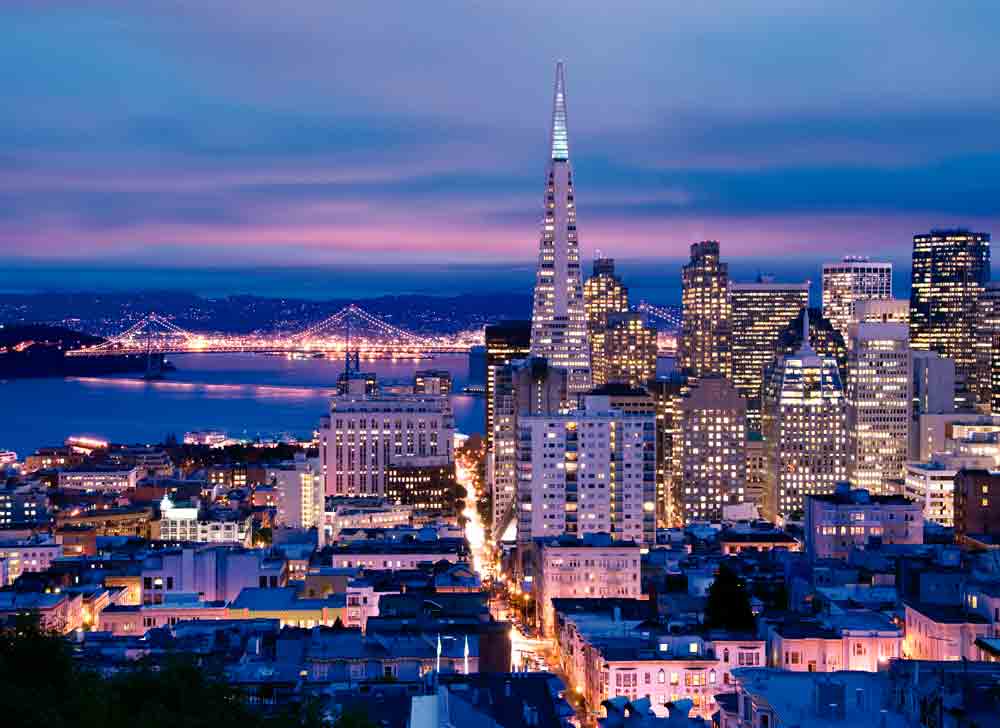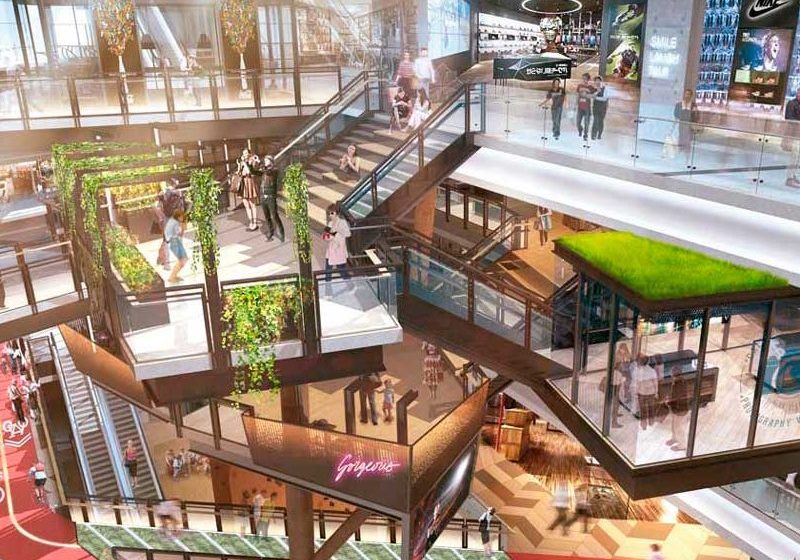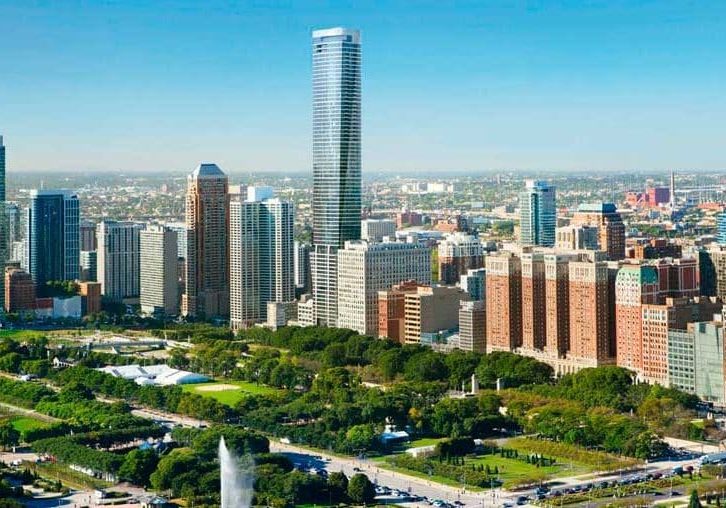Market Trends: Trending Up
Aug 1, 2017

From Southern California to Washington State, a West Coast construction boom that is transforming skylines means plenty of work for VT companies.
Fueled in large part by the technology boom, construction markets in cities on the U.S. West Coast are robust. The most noteworthy tall-building construction is taking place in these cities’ downtowns, where supertall skyscrapers are being built for people to live, work and play, and mixed use is the name of the game. There is also lots of activity related to airport, convention center and hotel expansion. Last year, Los Angeles, San Francisco and Seattle were vying for the “tallest tower west of the Mississippi River” title, and the 1,100-ft. tall Wilshire Grand in L.A. claimed it, as San Francisco’s Salesforce Tower will fall slightly shy at 1,070 ft. and plans for the 1,111-ft.-tall 4/C Tower in Seattle are on hold as developers deal with scrutiny from aviation authorities over height.[1]
L.A.’s Boom
The Wilshire Grand Center, the only tower taller than 40 floors to be built in downtown L.A. since Arthur Erickson Architects built the 750-ft.-tall Two California Plaza in 1992,[1] houses not only a 900-room hotel, but also office space, retail, ballrooms, meeting halls and a 1,250-space parking garage. It opened its doors in June amid much fanfare. Otis provided 52 units, including high-speed double-deck elevators and a bank of nearly 30 units outfitted with the energy-saving CompassPlusTM destination-dispatch system for it. Other companies involved were Lerch Bates Inc. for façade access and Prysmian for cabling.
This is just one of many L.A. projects generating work for vertical-transportation (VT) companies. Others include the Los Angeles International Airport (LAX) Bradley West Modernization Project, for which Syska Hennessy provided consulting and Otis the equipment, and an array of downtown projects that have resulted in installation of nearly 100 units by Mitsubishi Electric’s Cypress, California-based subsidiary (ELEVATOR WORLD, January 2017).
Kenneth Dietz, Lerch Bates regional manager, says downtown L.A. is the hottest market in southern California right now, with demand for labor creating a seller’s market as developers realize projects are financially viable at higher costs. “At this point, we’re not seeing any evidence that projects are not proceeding,” Dietz says. “Both downtown L.A. and San Diego are quite active. Activity in both markets is mostly characterized by mixed-use projects with a strong residential component,” with the “dire housing shortage” in L.A. driving much of this activity.
People increasingly want to live downtown, as illustrated by projects like Ten Thousand, a new 40-story residential tower at the intersection of Beverly Hills and Century City. Here, elevators that use Schindler’s PORT technology with controlled access to individual floors have been installed.
The L.A. skyline is changing dramatically, with 22 150-m-plus buildings proposed and 15 under construction, according to the Council on Tall Buildings and Urban Habitat (CTBUH). CTBUH Editor Daniel Safarik observes:
“In terms of anticipated tall-building construction completions by 2022, L.A. is the big winner. I think the story here is that the real-estate market has finally turned the corner to embrace mixed-use, high-density development, particularly in Hollywood and downtown, where transit density is highest. Developers are likely encouraged by the investment in new transit lines, such as the L.A. County Metropolitan Transportation Authority’s under-construction regional Connector Transit project. There is also a resurgence of interest in living downtown, which had been a ghost town for decades prior.”
Tall buildings planned or underway in L.A. include:[3]
- A 66-story mixed-use tower next door to the Hotel Figueroa that would become the third tallest in the city. Justin L.M. Leong is behind that project.
- The trio of under-construction mixed-use towers ranging from 40-49 stories that make up Oceanwide Plaza on a site across from L.A. Live
- A 60-story mixed-use “urban tree” with vegetation on the exterior designed by Nardi Associates in the South Park neighborhood
- Olympia, which would bring three mixed-used towers ranging from 43-65 stories to a site across from L.A. Live, along with a public park and plaza.
- A 714-ft.-tall (more than 60 stories) luxury residential tower in South Park, at the corner of 11th and Olive streets
- 6AM, a pair of 58-story mixed-use towers that would be the first skyscrapers in the Arts District
Big L.A. projects involving Lerch Bates include the four-tower “megaproject” Metropolis (EW March 2017) and Oceanwide, Dietz notes.
Otis reports its new-equipment, modernization and service sectors are thriving in the L.A. area, explaining:
“Based on the strength of the overall economy supported by a robust tech sector and major infrastructure projects, such as airport expansions and government buildings, as well as strong residential growth, the outlook is strong.”
Designs for downtown L.A. skyscrapers range from relatively conservative to daring. Safarik notes Wilshire Grand is the first tall building to be built in L.A. in many years with a non-flat roof. The structure’s internal fire-protection system allowed it to waive a decades-old requirement that tall buildings in L.A. have a rooftop helipad for fire evacuation, he says.
Other striking L.A. buildings on the drawing boards are a 55-story residential building designed by CallisonRTKL for developer Jeremy Fish that would be the first in the city with transparent pools jutting out from its façade.[2] Also on tap is a 52-story mixed-use structure by Gensler that resembles four irregularly shaped blocks stacked in a square with a cutaway in the center and landscaped outdoor terraces. That building is envisioned as a “gateway to downtown” and would be visible from Interstate 10.[2]
Industry Firsts, Urban Villages and Safety
The West Coast has seen several firsts in the U.S. in the past few years, and that is no surprise, given the region’s rapid growth and willingness to embrace new technology.
In Portland, Oregon, Safarik says, CTBUH knows of only one tall building under construction, “but it is an interesting one.” Framework, the first cross-laminated timber building in the U.S. to rise over 85 ft., received its construction permit in June and is expected to be complete sometime next year, he says.
Another U.S. first to happen on the West Coast was installation of an occupant evacuation operation (OEO) elevator system by thyssenkrupp for fire evacuation at 181 Fremont, a San Francisco skyscraper with 58 occupied floors that was completed in 2016.[4] The OEO system required a code variance from the State of California. The decision to use it was based on the building’s small footprint and the developer’s desire to maximize leasable space.
The system came with substantial upfront costs, as it required fire, smoke and water-resistant shafts and lobbies, as well as additional switches, digital signage and emergency-power generators, but is expected to be beneficial in the long run as a third stairwell was eliminated, and a total of 116,000 sq. ft. of leasable space was added.[3] 181 Fremont is the tallest residential building on the West Coast.[4]
OEO elevators are gaining popularity in San Francisco, as evidenced by The John Buck Co. awarding a contract to Schindler to provide 20 OEO units to the 43-story, 605-ft.-tall Park Tower at Transbay (EW, November 2016), which, upon completion, will be among the tallest buildings in the city.
OEO systems enhance safety, as do proposed updates to ASME A17.1 2013 being developed by the State of California that target machine-room-less (MRL) elevators. Luke Brown, information officer for California’s Department of Industrial Relations (DIR), tells EW where MRL systems stand now:
“There has never been a prohibition against MRL elevator installations in California, nor has a variance been required to have a drive machine in the hoistway. Many MRL elevators have been permitted in California absent a variance. [However], many other MRL elevators have required variances for such things as belted suspension, inset car-top railings and various other noncompliant design elements.”
Proposed updates address concerns about access to “critical safety elements” such as drive sheaves, brakes and governors, Brown says. These issues are not effectively addressed by current code, he says, and have resulted in numerous permit denials in California. “The division is concerned that a lack of safe access to these components is not just a worker-safety issue, but may lead to public-safety issues,” Brown says, as it could mean that components are not properly monitored and maintained.
The proposed measures, which Brown says have been “heavily vetted over the past three years by all interested parties,” require equipment in the hoistway to be safely accessible from the car top if access from outside the hoistway is not provided. As of June, the proposed updates were expected to be presented to the California Occupational Safety and Health Standards Board for consideration within the next few months.
Looking to Seattle
Another industry first in the U.S. happened in Seattle, where KONE debuted its JumpLift self-climbing elevator during construction of the Hyatt Regency Seattle (EW, February 2016). The 45-story hotel will be the largest in the Pacific Northwest with more than 1,260 rooms and help Seattle remedy a hotel-room shortage. More hotels are being built to go with an expansion of the Washington State Convention Center, which is doubling its capacity. The shortage of rooms means it’s critical new hotel projects come online as quickly as possible. JumpLift fits right into that equation, states Larry Wash, vice president for KONE Americas, who says:
“We believe that when VT is considered as part of the pre-construction process, construction productivity gains are a new reality. By installing JumpLift at the Hyatt Regency Seattle, we can move the workforce more efficiently and more safely, while delivering the construction project faster.”
Seattle’s construction boom is being fueled in no small part by the Amazon “engine,” observers note. Activity was laid out by the Seattle Times in 2016, which noted 65 major projects under construction (EW, September 2016). Of the office projects underway, one-third of it is for Amazon, which planned to occupy 12 million sq. ft. by the time projects are finished at the end of 2017. “A lot of attention is being paid to the Amazon campus rising in Seattle,” Safarik says. “Although, what most people are excited about is the biosphere-like domes at ground level, not so much about the skyscrapers.”
Still, skyscrapers are proliferating in Seattle, with 17 buildings taller than 150 m under construction and four proposed, according to CTBUH. All are scheduled to be complete by 2022. Towers planned or underway in the area include:
- A 41-story apartment building at 1812 Boren Avenue (EW, January 2016)
- 2+U, a 38-story office tower rising above an “outdoor urban village” with restaurant, retail and entertainment space at Second Avenue and University Street (EW, April 2017)
- Madison Centre, a 37-story “vertical corporate campus” at 910 5th Avenue for which Otis is providing the VT (EW, May 2016)
- 400 Lincoln Square and Two Lincoln Tower, a 31-story office building and 40-story hotel representing an expansion of Lincoln Centre in Bellevue. Lerch Bates designed the VT system (EW, March 2016).
- A US$200-million, 43-story residential tower at 600 Wall Street near the Space Needle (EW, August 2016)
The Space Needle itself is poised to undergo its biggest renovation in its 55-year history. The multiyear, multiphase Century Project was announced in June and will include an additional set of elevators.
While downtown Seattle is unquestionably a top destination for visitors, it is increasingly becoming a place people want to call home. Efforts are being made to enhance the city’s reputation as not only a destination, but also a convenient and comfortable place to live, as illustrated by CTBUH’s Seattle chapter holding a panel last year on “Transforming Downtown Seattle for Kids.” It focused on the need to create vibrant private and public space, with the consensus being that “engaging family living in downtown Seattle will be a vital component to the city’s growth.”[5]
“Beacon of the New Economy” in San Francisco
San Francisco is in the midst of what a city supervisor called the biggest construction boom since the 1906 earthquake.[1] At the moment, that may be best exemplified by the Salesforce Tower, which, at 1,070 ft. tall, is poised to become the tallest office building west of Chicago.[6] Scheduled for completion in 2018, Salesforce is indicative of a growing, tech-powered economy, as it was named for its anchor tenant Salesforce, a cloud-based software provider that has approximately 25,000 employees.[7]
Described by Cushman & Wakefield Managing Principal J.D. Lumpkin as “the beacon of the new economy,” Salesforce Tower will boast a destination-dispatch VT system by Schindler that includes four 400A and 30 7000 elevators, including two 7000s for service.
CTBUH says there are seven buildings taller than 150 m under construction in San Francisco, with an additional one proposed. Safarik says perhaps the most interesting San Francisco project is Oceanwide Center, which, besides its silvery, geometric profile, exemplifies how this and other West Coast downtowns are evolving. It consists of a 605-ft.-tall residential and 850-ft.-tall mixed-use tower that will be among the tallest residential buildings on the West Coast. Architect Foster + Partners describes it on its website:
“Significant in urban and environmental terms, the development brings together places to live and work with the city’s most important new transport hub (Transbay Terminal), further evolving a sustainable model of high-density, mixed-use development.
There is no question West Coast cities are keeping the elevator industry busy. John R. Moran, III, senior principal at Syska Hennessy Group, Inc., with offices in San Francisco and L.A., says his firm has been handling a good mix of new and modernization projects. The L.A., San Francisco and Seattle markets are currently strongest. Moran states:
“Infrastructure wise, we have a number of aviation projects in design or under construction, including the San Diego International Airport, San Francisco International Airport and LAX. Hotels and convention centers are also a big part of our project mix.”
Huge international companies, family-run independents and others expect business to stay strong. Mike Moss, senior sales associate at Schumacher Elevator Co. of Denver, Iowa, works with West Coast partners on custom commercial and residential projects (see “Square Peg for a Round Hole,” page ???). Moss says while customer preference is “across the board,” a few trends have emerged, such as greater demand for high-end elevators for high-end homes. “We are seeing fewer and fewer installations done out of necessity, such as for the elderly or those with mobility issues,” he says. “That market may have shifted towards less expensive lift options or retirement-community living.”
Moss continues:
“I don’t see us slowing down anytime in the next five years. The West Coast wholesale market has grown in recent years, largely because of great relationships with independent elevator contractors and other custom projects that the majors source through us. Residential construction growth overall in California has been steady, about 2% above the national average, accounting for 8% of permits issued in the U.S. Looking at state permits issued, commercial growth has seen a 20% or greater increase in the past few years. I think our challenge will be getting labor in place to handle growth. We know the new-construction industry has its ups and downs, but I think we are still on the upward road.”
References:
[1] Pacheco, Antonio. “Seattle, San Francisco, and Los Angeles Vie for Tallest Tower West of the Mississippi,” ArchDaily, June 21, 2016.
[2] Chandler, Jenna. “Mapping the Rise of L.A.’s Tallest Towers,” Curbed L.A., February 21, 2017.
[3] Post, Nadine M., “San Francisco Tower to Use Elevators for Fire Evacuations,” Engineering News-Record, September 21, 2015.
[4] Robinson, Melia. “This $665 Million Skyscraper in San Francisco Will be the Tallest Residential Building on the West Coast,” Business Insider, November 15, 2016.
[5] “CTBUH Seattle Chapter Hosts Spring Forum,” ctbuh.org, April 14, 2016.
[6] Levitt, David M. “San Francisco Skyline Remade by Tallest West Coast Office Tower,” Bloomberg Technology, April 7, 2017.
[7] “The World’s Biggest Public Companies (as of May 2017),” Forbes, (forbes.com/companies/salesforce), accessed June 26, 2017.
Get more of Elevator World. Sign up for our free e-newsletter.









